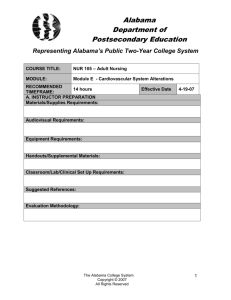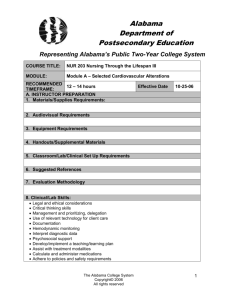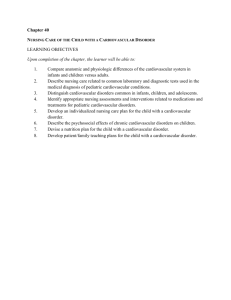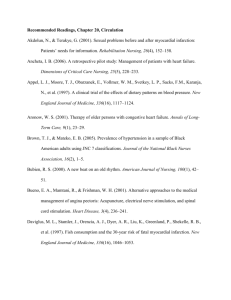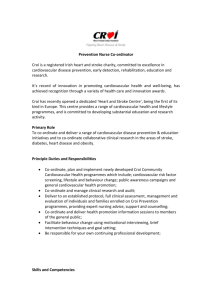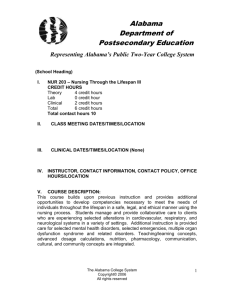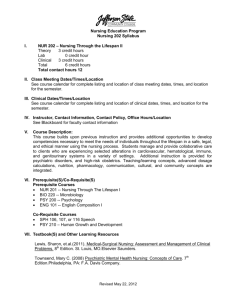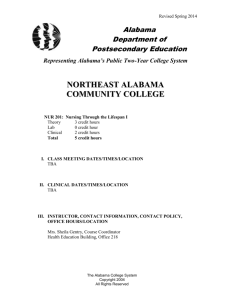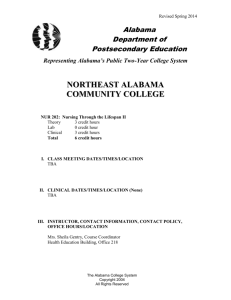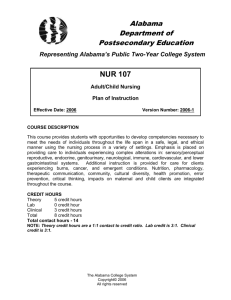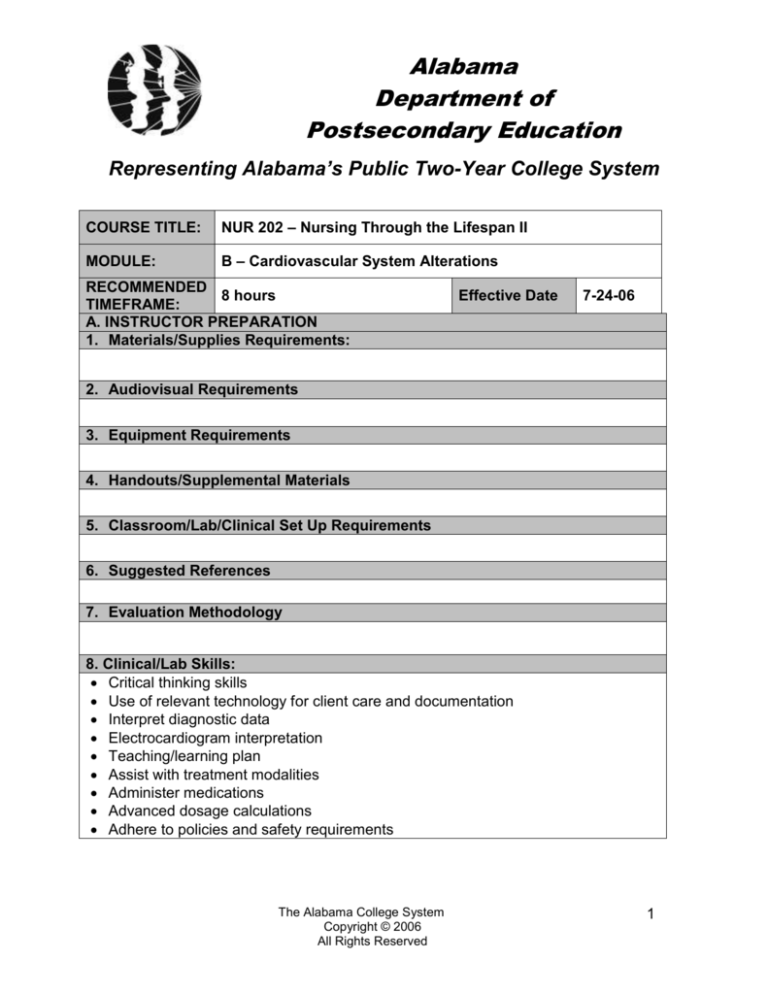
Alabama
Department of
Postsecondary Education
Representing Alabama’s Public Two-Year College System
COURSE TITLE:
NUR 202 – Nursing Through the Lifespan II
MODULE:
B – Cardiovascular System Alterations
RECOMMENDED
8 hours
TIMEFRAME:
A. INSTRUCTOR PREPARATION
1. Materials/Supplies Requirements:
Effective Date
7-24-06
2. Audiovisual Requirements
3. Equipment Requirements
4. Handouts/Supplemental Materials
5. Classroom/Lab/Clinical Set Up Requirements
6. Suggested References
7. Evaluation Methodology
8. Clinical/Lab Skills:
Critical thinking skills
Use of relevant technology for client care and documentation
Interpret diagnostic data
Electrocardiogram interpretation
Teaching/learning plan
Assist with treatment modalities
Administer medications
Advanced dosage calculations
Adhere to policies and safety requirements
The Alabama College System
Copyright © 2006
All Rights Reserved
1
Nursing Through the Lifespan II
Module B
NUR 202
B. SUGGESTED PRESENTATION METHODS
1. COMPETENCIES AND OBJECTIVES
COMPETENCY
STUDENT PERFORMANCE OBJECTIVES
B1.0 Provide nursing care for clients
B1.1 Apply the nursing process for clients
experiencing selected
cardiovascular system alterations.
experiencing selected cardiovascular
system alterations.
Instructor Notes:
ACS Copyright © 2006
All Rights Reserved
2
Nursing Through the Lifespan II
Module B
NUR 202
B. SUGGESTED PRESENTATION METHODS
2. LEARNING OBJECTIVES
B1.1.1 Define terms associated with selected cardiovascular system alterations.
B1.1.2 Describe selected cardiovascular system alterations.
B1.1.3 Describe the pathophysiology associated with selected cardiovascular
system alterations.
B1.1.4 Explain complications associated with myocardial infarction (MI).
B1.1.5 Describe the role of the nurse in providing care for clients experiencing
selected cardiovascular system alterations.
B1.1.6 Explain health promotion related to selected cardiovascular system
alterations.
B1.1.7 Interpret clinical manifestations of selected cardiovascular system alterations.
B1.1.8 Interpret diagnostic tests for selected cardiovascular system alterations.
B1.1.9 Describe the pharmacological agents and/or treatments for selected
cardiovascular system alterations.
B1.1.10 Evaluate nutritional considerations for clients experiencing selected
cardiovascular system alterations.
B1.1.11 Identify expected outcomes of treatment modalities for clients experiencing
selected cardiovascular system alterations.
B1.1.12 Evaluate psychosocial needs of clients, families, and/or support systems.
B1.1.13 Use critical thinking to manage nursing care for culturally diverse clients
experiencing selected cardiovascular system alterations.
B1.1.14 Evaluate expected outcomes of nursing care for clients experiencing selected
cardiovascular system alterations.
B1.1.15 Assess the impact of selected cardiovascular system alterations on pediatric
clients.
Instructor Notes:
ACS Copyright © 2006
All Rights Reserved
3
Nursing Through the Lifespan II
Module B
NUR 202
D. LESSON DEVELOPMENT
Theory = T
Lab = L
Clinicals = C
T
T
L
MAIN POINTS
C
C
C
1.0 Conduction System
1.1 Causes of Dysrhythmias
1.2 Types
1.2.1 Normal Sinus Rhythm
1.2.2 Sinus Bradycardia
1.2.3 Sinus Tachycardia
1.2.4 Atrial Fibrillation/flutter
1.2.5 Paroxysmal Supraventricular Tachycardia
1.2.6 Atrio-ventricular Block
1.2.7 Atrio-ventricular Tachycardia
1.2.8 Premature Ventricular Complex
1.2.9 Ventricular Tachycardia
1.2.10 Ventricular Fibrillation
1.3 Pathology
1.4 Clinical Manifestations
1.5 Diagnostic Tests
1.6 Treatment modalities
1.6.1 Medical management
1.6.2 Pharmacological Agents
1.6.3 Nutritional Considerations
1.7 Application of the nursing process
ACS Copyright © 2006
All Rights Reserved
4
Nursing Through the Lifespan II
Module B
T
C
NUR 202
2.0 Coronary Artery Disease
2.1 Causes
2.2 Types
2.2.1 Angina
2.2.2 Myocardial Infarction
2.2.3 Complicated Myocardial Infarction
Cardiac tamponade
Myocardial rupture
Cardiogenic shock
Ventricular rupture
Ventricular aneurysm
2.3 Pathology
2.4 Clinical Manifestations
2.5 Diagnostic Tests
2.5.1 Serum
2.5.1.1 Cardiac enzymes
2.5.1.2 Troponin
2.5.1.3 Lipid profile
2.5.1.4 Electrolytes
2.5.1.5 Prothrombin times
2.5.1.6 Partial Prothromboplastin Time
2.5.1.7 International Normalized Ratio
2.5.2 Radiologic Tests
2.5.2.1 Chest X-ray
2.5.2.2 Echocardiogram
2.5.2.3 Transesophageal Echocardiagram
2.5.3 Exercise Stress Testing
2.5.3.1 Graded Exercise Tolerance
2.5.3.2 Thallium
2.5.3.3 Persantine
2.5.4 Cardiac Catherization
2.6 Cardiac surgical interventions for MI
2.7 Treatment Modalities
2.7.1 Pharmacological Agents
2.7.1.1 Cardiac Glycosides
2.7.1.2 Anticoagulants
2.7.1.3 Dysrhythmics
2.7.1.4 Anti-thrombolytics
2.7.1.5 Nitrates
2.7.1.6
Anti-lipemics
2.7.2 Nutritional Considerations
2.7.2.1 Low Fat/Low Cholesterol
2.7.2.2 High Fiber
2.7.2.3 Weight Reduction
2.7.2.4 Sodium Restriction
2.7.2.5 Clear Liquid
2.8 Application of the nursing process
ACS Copyright © 2006
All Rights Reserved
5
Nursing Through the Lifespan II
Module B
NUR 202
E. ASSIGNMENTS AND DUE DATES
F. SUMMARY AND REVIEW
ACS Copyright © 2006
All Rights Reserved
6

